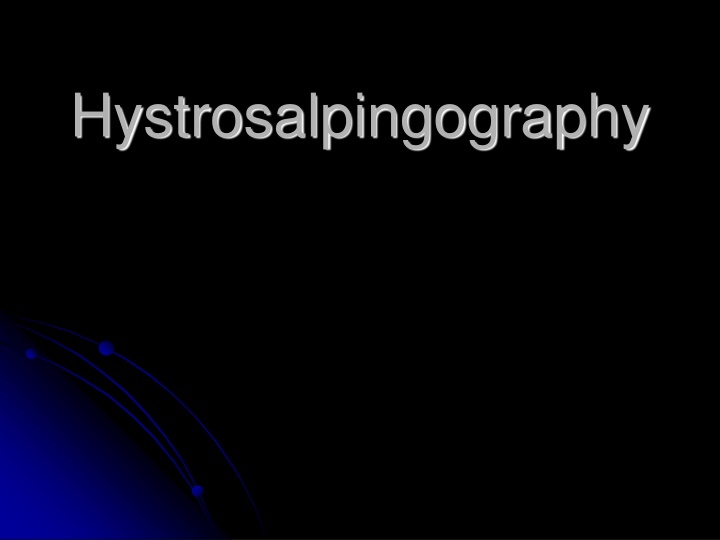Hystrosalpingography
Hystrosalpingography, a diagnostic procedure, is used to evaluate infertility causes, uterine anomalies, and tubal patency post-surgery. It involves injecting contrast dye into the uterus and fallopian tubes. The timing of the procedure is crucial to ensure clear imaging. Irregular uterine bleeding and contraindications such as pregnancy, infection, and sensitivity to contrast media should be noted. Possible complications include pain, infection, hemorrhage, and allergic reactions.
Download Presentation

Please find below an Image/Link to download the presentation.
The content on the website is provided AS IS for your information and personal use only. It may not be sold, licensed, or shared on other websites without obtaining consent from the author.If you encounter any issues during the download, it is possible that the publisher has removed the file from their server.
You are allowed to download the files provided on this website for personal or commercial use, subject to the condition that they are used lawfully. All files are the property of their respective owners.
The content on the website is provided AS IS for your information and personal use only. It may not be sold, licensed, or shared on other websites without obtaining consent from the author.
E N D
Presentation Transcript
Indications 1.Infertility : tubal obstruction , congenital uterine anomalies . 2.After tubal surgery: patency and configuration of F.T. 3.Recurrent abortion : cervical canal , congenital anomalies , fibroids.
Indications 1. Abnormal uterine bleeding : fibroids , endometrial polyps, adenomyosis, uterine adhesions. 2. Post caesarian section : assess integrity of uterine scar. 3. Intervention : tubal recanalization .
Timing Day 4-7 Why? Blood has cleared from uterus. o Isthmus is most distensible. o Fallopian tubes are more readily filled. o Endometrium is not thick.
Irregular uterine bleeding BLOOD CLOTS MAY MIMIC INTRAUTERINE LESIONS DO NOT USE OIL SOLUBLE CONTRAST MEDIUM
Contraindications 1.Pregnancy. 2.Pelvic infection 3.Immediate pre and post menstrual phases. (Extravasations). 4.Sensitivity to contrast media.
Complications 1.Pain: normally transit lower abdominal discomfort. 2.Pelvic infection 3.Hemorrhage . 4.Allergic ,vasovagal attach. 5.Venous intravasation.
HSG ANTIBIOTICS: ANTIBIOTICS: +ve history of PID and SBE +ve history of PID and SBE (Doxycycline 100 mg/twice daily two days before procedure) (200mg immediately after procedure followed by 100mg/twice daily for 5 days)
CONTRAST MEDIA WATER SOLUBLE Less density Better for FT visualization Immediate smear Disappear within one hour (except tubal block) Less complication No therapy effect.
CONTRAST MEDIA OIL SOLUBLE More density Better uterine visualization Delayed smear Disappearance is delayed More complications Has a therapy effect.
HSG It is best performed in the first half of the menstrual cycle. Venous intravasations has no clinical significance. Pethidine is not suitable analgesia for any discomfort during the examination because it tubal spasm.
TECHNIQUE TECHNIQUE Ask the patient to evacuate her bladder. Patient lies in lithotomy position and try to elevate her buttocks. Lubricate speculum. Insert it closed; then rotate; then open it.
TECHNIQUE TECHNIQUE Sterilize vagina. Grasp anterior lip with vulsellum forceps (avoid 3&9 o clock: highly vascular) Insert cannula inside the cervical canal. Inject contrast material.
HSG UTERINE CAVITY THE CAVITY IS TRIANGULAR IN SHAPE WALLS ARE REGULAR AND CONCAVE FUNDUS MAY BE CONVEX LENGTH AND INTERCORN. DIST. ARE ABOUT 35MM
Fallopian Tube ABOUT 7-14 CM LONG DEVIDED INTO: INTERSTITIAL ISTHMIC AMPULLARY INFUNDIBULAR FIMBRIAL
Fallopian Tube Longitudinal mucosal folds indicate a healthy mucosa
COBBLESTONE MUCOSA
LONGITUDINAL BANDS
Pelvic adhesions Pelvic adhesions CONTRAST LOCULATION Vertical tube orientation Fixed uterine position
CONTRAST LOCULATION
PITFALSS PITFALSS AIR BUBBLES REMOVE AIR BUBBLES FROM CANNULA ADDITIONAL CONTRAST INJECTION CHANGE PATIENT POSITION
PITFALSS PITFALSS VENOUS INTRAVASATION FORCEFUL INJECTION AGAINST BLOCKED TUBES VERY DANGEROUS IF WE USE OIL SOL. CONTRAST

